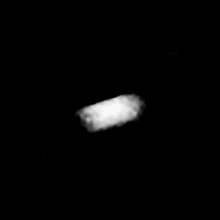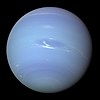ഗാലത്തിയ
 Galatea as seen by Voyager 2 (elongation is due to smearing) | |
| കണ്ടെത്തൽ | |
|---|---|
| കണ്ടെത്തിയത് | Stephen P. Synnott[1] and Voyager Imaging Team |
| കണ്ടെത്തിയ തിയതി | July 1989 |
| വിശേഷണങ്ങൾ | |
| ഉച്ചാരണം | /ɡæləˈtiːə/[2] |
പേരിട്ടിരിക്കുന്നത് | Γαλάτεια Galateia |
| Adjectives | Galatean[3] |
| ഭ്രമണപഥത്തിന്റെ സവിശേഷതകൾ[4][5] | |
| ഇപ്പോക്ക് 18 August 1989 | |
| 61 952.57 km | |
| എക്സൻട്രിസിറ്റി | 0.00022 ± 0.00008 |
| 0.42874431 ± 0.00000001 d | |
| ചെരിവ് |
|
| ഉപഗ്രഹങ്ങൾ | Neptune |
| ഭൗതിക സവിശേഷതകൾ | |
| അളവുകൾ | 204×184×144 km (±~10 km)[6][7] |
ശരാശരി ആരം | 87.4 ± 4.9 km[5] |
| വ്യാപ്തം | ~2.8×106km³ |
| പിണ്ഡം | 2.12 ± 0.08 ×1018 kg[8] |
ശരാശരി സാന്ദ്രത | ~0.75 g/cm³ (estimate)[9] |
| ~0.018 m/s2[a] | |
| ~0.056 km/s[b] | |
| synchronous | |
| zero | |
| അൽബിഡോ | 0.08[6][9] |
| താപനില | ~51 K mean (estimate) |
| 21.9[9] | |
നെപ്റ്റ്യൂണിന്റെ ഒരു ഉപഗ്രഹമാണ് ഗാലത്തിയ. 1989 ൽ വോയേജർ 2 എടുത്ത ചിത്രങ്ങളുടെ സഹായത്തോടെയാണ് ഇതിനെ കണ്ടുപിടിച്ചത്. നെപ്ട്യൂണിൽ നിന്നും ശരാശരി 62,000 കിലോമീറ്റർ അകലെയുള്ള നെപ്ട്യൂണിന്റെ മദ്ധ്യരേഖയ്ക്കു സമാന്തരമായി വൃത്താകൃതി സഞ്ചാരപഥത്തിലൂടെ 10 മണിക്കൂർ സമയം കൊണ്ട് ഒരു പ്രദക്ഷിണം വയ്ക്കുന്നു.
ക്രമ രൂപമില്ലാത്ത ഇതിന്റെ ശരാശരി വ്യാസം 150 കിലോമീറ്ററാണ്. സാന്ദ്രത, ഘടന, ആന്തരികസ്വഭാവം മുതലായവയുടെ വിശദാംശങ്ങൾ ഇപ്പോഴും ലഭ്യമല്ല. ഇരുണ്ടതാണെന്നതിൽ കവിഞ്ഞ് ഇതിന്റെ ഉപരിതലത്തെക്കുറിച്ചും കൂടുതലൊന്നും അറിഞ്ഞുകൂടാ. വളരെ ചെറുതായതുകൊണ്ട് അന്തരീക്ഷത്തിനുള്ള സാധ്യതയില്ല. അതുപോലെ ഭൗമപ്രവർത്തനങ്ങളുടെ ലക്ഷണവുമില്ല. നെപ്ട്യൂണിനു ചുറ്റുമുള്ള വളയങ്ങൾക്ക് നടുവിലായി പ്രദക്ഷിണം ചെയ്യുന്നതുകൊണ്ട് ഇതിന്റെ ഗുരുത്വാകർഷണം വശങ്ങളിലുള്ള വലയങ്ങളിലെ കണങ്ങളെ വേർപെട്ടുപോകാതെ നിലനിർത്തുന്നു. അതുകൊണ്ട് ഇതിനെ 'ഇടയ ഉപഗ്രഹം' എന്നു വിളിക്കുന്നു.
അവലംബം[തിരുത്തുക]
- ↑ Planet Neptune Data http://www.princeton.edu/~willman/planetary_systems/Sol/Neptune/
- ↑ "galatea". Oxford English Dictionary (3rd ed.). Oxford University Press. September 2005.
{{cite book}}: Cite has empty unknown parameter:|month=(help); External link in|chapterurl=|chapterurl=ignored (|chapter-url=suggested) (help) - ↑ AMIA (1999) Transforming health care through informatics
- ↑
Jacobson, R. A.; Owen, W. M., Jr. (2004). "The orbits of the inner Neptunian satellites from Voyager, Earthbased, and Hubble Space Telescope observations". Astronomical Journal. 128 (3): 1412–1417. Bibcode:2004AJ....128.1412J. doi:10.1086/423037.
{{cite journal}}: CS1 maint: multiple names: authors list (link) - ↑ 5.0 5.1 Showalter, M. R.; de Pater, I.; Lissauer, J. J.; French, R. S. (2019). "The seventh inner moon of Neptune" (PDF). Nature. 566 (7744): 350–353. Bibcode:2019Natur.566..350S. doi:10.1038/s41586-019-0909-9. PMC 6424524. PMID 30787452.
- ↑ 6.0 6.1 Karkoschka, Erich (2003). "Sizes, shapes, and albedos of the inner satellites of Neptune". Icarus. 162 (2): 400–407. Bibcode:2003Icar..162..400K. doi:10.1016/S0019-1035(03)00002-2.
- ↑ Williams, Dr. David R. (2008-01-22). "Neptunian Satellite Fact Sheet". NASA (National Space Science Data Center). Retrieved 2008-12-13.
- ↑ Porco, C.C. (1991). "An Explanation for Neptune's Ring Arcs". Science. 253 (5023): 995–1001. Bibcode:1991Sci...253..995P. doi:10.1126/science.253.5023.995. PMID 17775342. S2CID 742763.
- ↑ 9.0 9.1 9.2 "Planetary Satellite Physical Parameters". JPL (Solar System Dynamics). 2008-10-24. Retrieved 2008-12-13.
പുറത്തേക്കുള്ള കണ്ണികൾ[തിരുത്തുക]
- Galatea Profile by NASA's Solar System Exploration
- Neptune's Known Satellites (by Scott S. Sheppard)
കുറിപ്പുകൾ[തിരുത്തുക]
ഉദ്ധരിച്ചതിൽ പിഴവ്: <ref> റ്റാഗുകൾ "lower-alpha" സംഘത്തിൽ ഉണ്ട്, പക്ഷേ ബന്ധപ്പെട്ട <references group="lower-alpha"/> റ്റാഗ് കണ്ടെത്താനായില്ല



